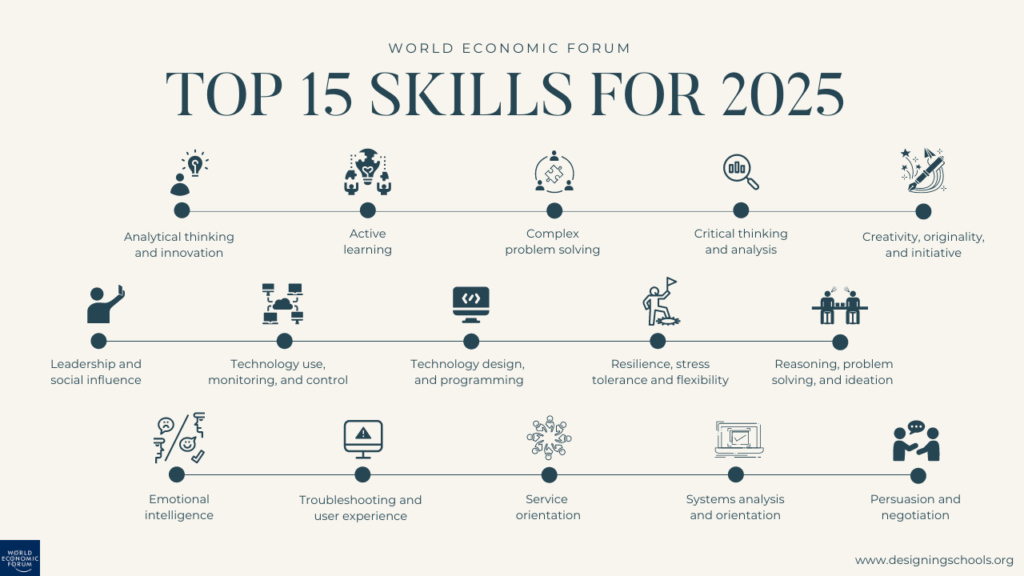I used to think Grammarly was “just a spell check” app. But when I saw their report on, “The State of Business Communication in 2024,” I was surprised to learn just how wrong I was.
I was impressed by the research they shared such as:
- 88% of people spend almost their entire workweek communicating
- Workers spend 19 hours on writing tasks

What We Can Learn From Grammarly About Leadership and Social Influence
As I read the report, fascinated more and more with each page, I realized:
Grammarly took this opportunity to reshape the narrative. We know that cheating is at the forefront of the conversation when it comes to written communication and Generative AI.
It’s a wonderful example of leadership and social influence, a trending skill identified by the World Economic Forum.

This emphasis on empathy and user-centered design is precisely why we advocate a design thinking approach to AI integration. By prioritizing the human experience at every step, we ensure technology not only meets but anticipates and responds to the nuanced needs of its users.
We call these “User Personas.”
How Can We Turn 19 Hours Into 9 Hours?
After reflecting on the ideas shared I began to wonder: how might we help people turn 19 hours into 9. That’s a reduction of 10 hours and an entire workday, including average commute time.
While the simple answer is to just enter a ChatGPT prompt to request help drafting an email, the same task over and over again becomes tedious. A better approach is to create your own Custom GPT inside of ChatGPT.
In this week’s YouTube video I’m sharing a lesson from my online course: The AI Bootcamp, where I share how to create the instructions for your GPT using a method from design thinking called, “Creating a User Persona.”
(P.S. If you can write a text, you can create a Custom GPT.)
How Do You Create a Successful Custom GPT?
The key to building a custom GPT that acts as a high performing member of your team lies in giving it instructions aligned to your needs. It’s similar to an onboarding process when we bring on a new hire. We share our values, standard operating procedures, and much more. And just like a new hire, it takes a little while to learn.
After building your custom GPT you’ll go back and forth a little as you refine your instructions. I’ve created a Canva template that you can use to create your instructions.
And with just a few iterations of your GPT, 19 hours can become 9!
So tell me what would you do with an extra day a week? What could your team do?
Before You Build
It’s important to note the data privacy differences between building in ChatGPT4 on a personal account, and building in ChatGPT Teams. When working in ChatGPT Teams you have enterprise grade privacy, and you can share across your teams. With ChatGPT4 you are still using it as a consumer so the same data privacy settings don’t apply as they do with Teams. Press “Reply” and let’s discuss if you have any questions at all.
Download Your Free Guide to the Video
To complement the video and help you turn ideas into impact, you can download this free guide where I share a Canva template you can use, and that you can share with your teams to help them build their own custom GPTs.
Shifting our mindset to see AI tools as members of our team, allows us to truly realize the promise of saving time, so we can focus on what matters most.
Book Dr. Quidwai for a Keynote or Workshop
It’s these design thinking strategies that make our workshops unique. Our human centered approach places people at the center, not technology, reducing fear, and increasing curiosity and confidence. At Designing Schools we offer both in-person and virtual experiences.
To learn more visit our Services page.

I’m Sabba.
I believe that the future should be designed. Not left to chance.
Over the past decade, using design thinking practices I've helped schools and businesses create a culture of innovation where everyone is empowered to move from idea to impact, to address complex challenges and discover opportunities.
stay connected
designing schools